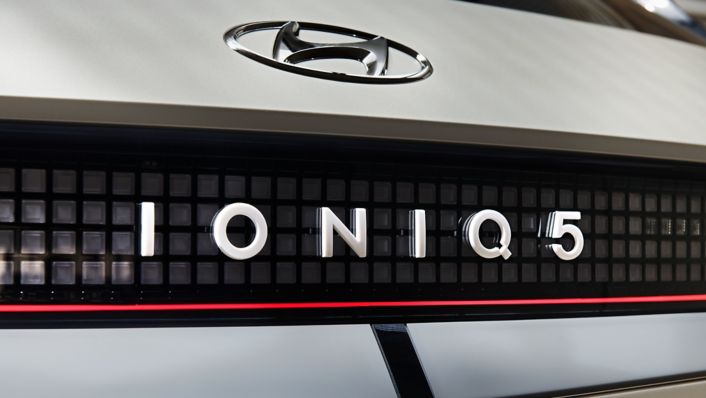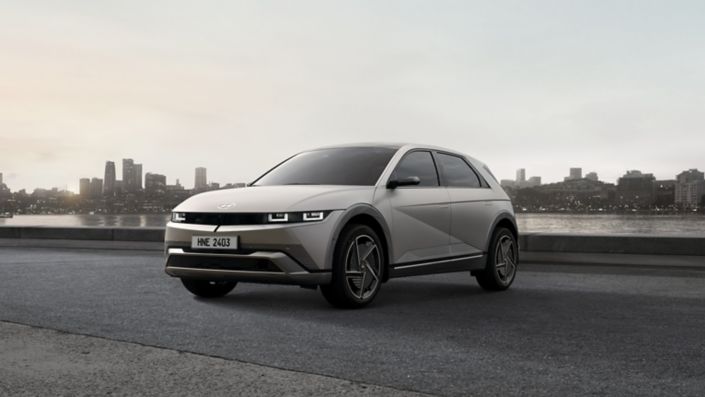- IONIQ 5 is celebrating victory in two comparison tests by Germany’s Auto Bild, Europe’s largest automotive trade magazine
- Hyundai’s fully-electric midsize CUV outperformed Mercedes EQB in four categories in issue 09/2022: Body, Powertrain, Driving Dynamics and Costs
- IONIQ 5 continued its winning streak in issue 12/2022 against the Audi Q4 e-tron and Polestar 2, coming out on top in Body, Comfort, Driving Dynamics and Sustainability categories
- Since its launch, IONIQ 5 has won other comparison tests and ten Car of the Year awards
Press material
-
Download
-
Images
Hyundai’s IONIQ 5 has continued its winning streak in two recent comparison tests by German automobile magazine Auto Bild. The editors of Europe’s largest automotive trade magazine declared Hyundai’s fully-electric midsize CUV the victor over the Mercedes EQB in four categories in issue 09/2022. This test was also published in issue 04/2022 of Auto Bild Allrad. Meanwhile, IONIQ 5 also outperformed the Audi Q4 e-tron and the Polestar 2 in another comparison test from the most recent issue of the magazine.
To assess BEVs in comparison tests, Auto Bild utilises seven categories: Body, Comfort, Powertrain, Driving Dynamics, Connected Car, Sustainability, and Costs. Up to 800 points are available for competing models.
In the earlier comparison test against the Mercedes EQB, IONIQ 5 scored higher than the Mercedes EQB in Body, Powertrain, Driving Dynamics, and Costs while tying with the competitor in Sustainability. Hyundai’s fully-electric midsize CUV took first place with a score of 582 points, receiving 20 points more than its rival.

“Hyundai IONIQ 5 offers more space, better driving performance, and better charging technology than the Mercedes EQB,” said Auto Bild. “On top of that, it also comes with great brakes and an outstanding warranty.”
In the most recent comparison test against the Audi Q4 e-tron and Polestar 2, IONIQ 5 came out on top in the Body, Comfort, Driving Dynamics and Sustainability categories. The Auto Bild editors awarded the model 573 points. The German publication declared IONIQ 5 the winner “for lots of space and equipment, superior driving performance and elaborate e-technology."
In addition to triumphing in two recent Auto Bild comparison tests, IONIQ 5 was also the top performer in Auto Zeitung’s comparison test of electric SUVs and CUVs earlier this month. Since the model’s launch one year ago, it has also won ten Car of the Year awards in Europe and was a finalist in the 2022 European Car of the Year.
By outperforming strong competitors in two comparison tests from a prestigious publication like Auto Bild, Hyundai has proven, once again, that we are leading the way when it comes to electric mobility in Europe. We designed our fully-electric midsize CUV based on our customers’ needs, and in doing so, we created a revolutionary electric vehicle with a spacious design, top on-road performance, and innovative charging technology.
Expressive design with plenty of space
For the earlier comparison test, the editors of Auto Bild lauded IONIQ 5 for its spectacular design that continues in the interior. “IONIQ 5 looks like an Italian design study from the 90s that Hyundai transported to the present.” The German automobile magazine continued, saying that IONIQ 5 is “even more spacious than the Mercedes EQB”.
The fully-electric midsize CUV is the first model to be based on Hyundai Motor Group’s first dedicated BEV platform – the Electric-Global Modular Platform (E-GMP). Thanks to E-GMP, IONIQ 5 features a flat floor, a sliding Universal Island centre console, and a roomy, sliding rear seat for more freedom of movement.
IONIQ 5 also provides plenty of cargo room. Customers can take advantage of 527 litres of cargo space and up to 1,587 litres with the seats folded down. The frunk also offers up to 57 litres of additional storage room.
A responsive powertrain for a lively ride
The configuration of IONIQ 5 that Auto Bild used against the Mercedes EQB was the version with the long range battery pack (72.6-kWh) and all-wheel drive. With a system outlet of 305 PS and 605 Nm of torque, IONIQ 5 accelerated faster than its competitor, reaching 185 km/h with ease.
The editors of Auto Bild preferred IONIQ 5’s driving dynamics over those of the Mercedes EQB. “IONIQ 5 offers remarkably good traction. The steering responds directly, so it feels more lively and agile than the Mercedes EQB.”
In the second comparison test, the German publication’s journalists also used the standard battery pack version (72.6-kWh), and IONIQ 5’s driving dynamics were also preferred over the Audi Q4 e-tron and the Polestar 2. “The power can be finely dosed, while the recuperation is adjustable. The i-pedal mode works particularly well. This allows IONIQ 5 to be moved effortlessly using only the accelerator pedal - right up to a standstill, in a very pleasant way.”
Ultra-fast charging
The editors of Auto Bild applauded IONIQ 5’s charging capabilities in both tests. Thanks to the 220 kW charging power of its 800-volt ultra-fast charging technology, IONIQ 5 can be charged from 10 to 80 per cent in just 18 minutes, which compares favourably to its competitors. The Mercedes EQB only offers 100 kW charging power, requiring 32 minutes to charge the same amount. The Polestar 2 offers up to 155 kW, which corresponds to a charging time of 35 minutes. Meanwhile, the Audi Q4 e-tron offers a maximum of 135 kW, which equates to 29 minutes (from five to 80 per cent). Additionally, less than five minutes of charging adds up to 100 kilometres of driving range to IONIQ 5.
IONIQ 5 also boasts bi-directional charging technology, known as Vehicle-to-Load (V2L). V2L enables the BEV to operate other electric machinery (110V / 220V), including charging other vehicles anywhere.
In the second half of 2022, customers in Europe will be able to purchase an enhanced IONIQ 5 thanks to the introduction of the 2023 model year. The updated IONIQ 5 will be outfitted with a new 77.4-kWh battery and offer a series of new features, including video-based digital mirrors and battery conditioning.
Building a more sustainable future
On top of producing models that generate zero carbon emissions at the tailpipe, Hyundai also shows its commitment to sustainability by incorporating eco-friendly materials in many touchpoints of IONIQ 5. The coverings of the seats and door armrests are made from recycled plastic bottles, wool, or leather processed with vegetable oil. Sustainable materials extracted from sugar cane are used in the crash pads, door trims, PET carpet, floor mats, and headliners. The door trims, switches, and modular crash pads include sustainable materials derived from plant-based oil extracted from rapeseed and corn. The door trim garnish panels are made of paperette, a recyclable material that feels like paper.
Hyundai also aims to showcase the benefits of a circular economy. Through a partnership with marine conservation organisation Healthy Seas, abandoned fishing nets are recovered and transformed into a new resource. One of Healthy Seas’ partners, Aquafil, regenerates the nylon parts of the nets along with other nylon waste into ECONYL®, a nylon yarn for sustainable products like the floor mats available in IONIQ 5.
Disclaimer: CO2 and emissions data
- Electricity consumption combined for the Hyundai IONIQ 5 58 kWh with 2WD in kWh/100 km: 16.7; CO2 emissions combined in g/km: 0 (WLTP)
- Electricity consumption combined for the Hyundai IONIQ 5 58 kWh with 4WD in kWh/100 km: 18.1; CO2 emissions combined in g/km: 0 (WLTP)
- Electricity consumption combined for the Hyundai IONIQ 5 72.6 kWh (19” alloy rims) with 2WD in kWh/100 km: 16.8; CO2 emissions combined in g/km: 0 (WLTP)
- Electricity consumption combined for the Hyundai IONIQ 5 72.6 kWh (20” alloy rims) with 2WD in kWh/100 km: 17.9; CO2 emissions combined in g/km: 0 (WLTP)
- Electricity consumption combined for the Hyundai IONIQ 5 72.6 kWh (19” alloy rims) with 4WD in kWh/100 km: 17.7; CO2 emissions combined in g/km: 0 (WLTP)
- Electricity consumption combined for the Hyundai IONIQ 5 72.6 kWh (20” alloy rims) with 4WD in kWh/100 km: 19.0; CO2 emissions combined in g/km: 0 (WLTP)
- IONIQ 5 with the 77.4 kWh battery is not currently available for sale in Europe. Electricity consumption and CO2 values for this model have not yet been determined











